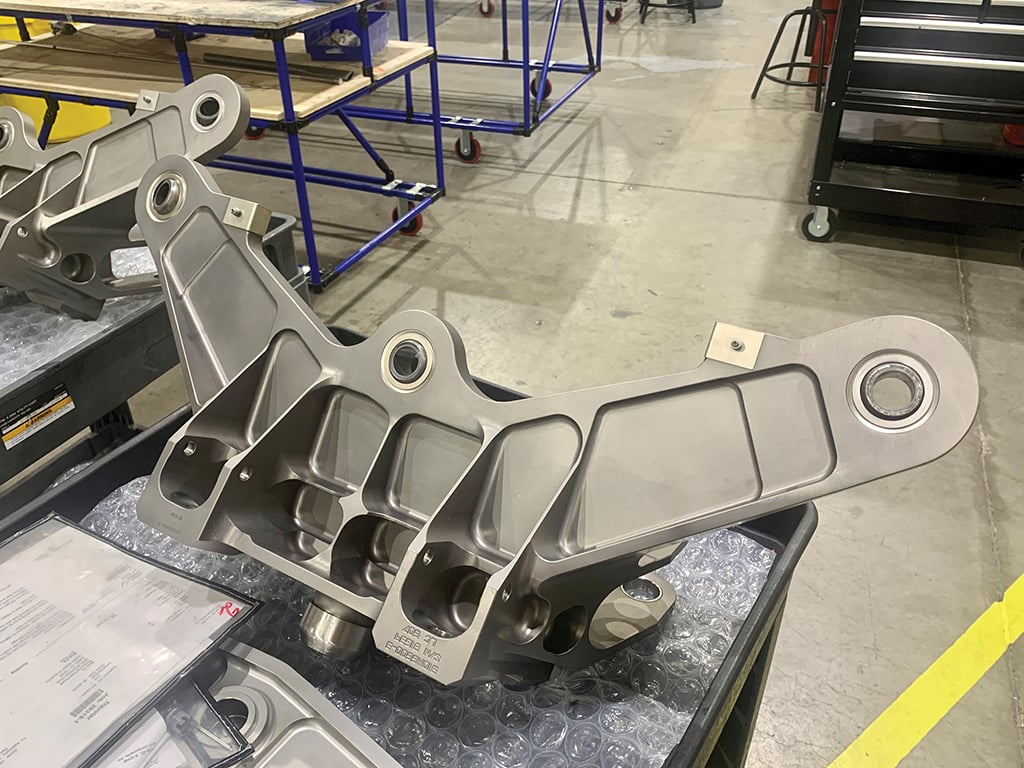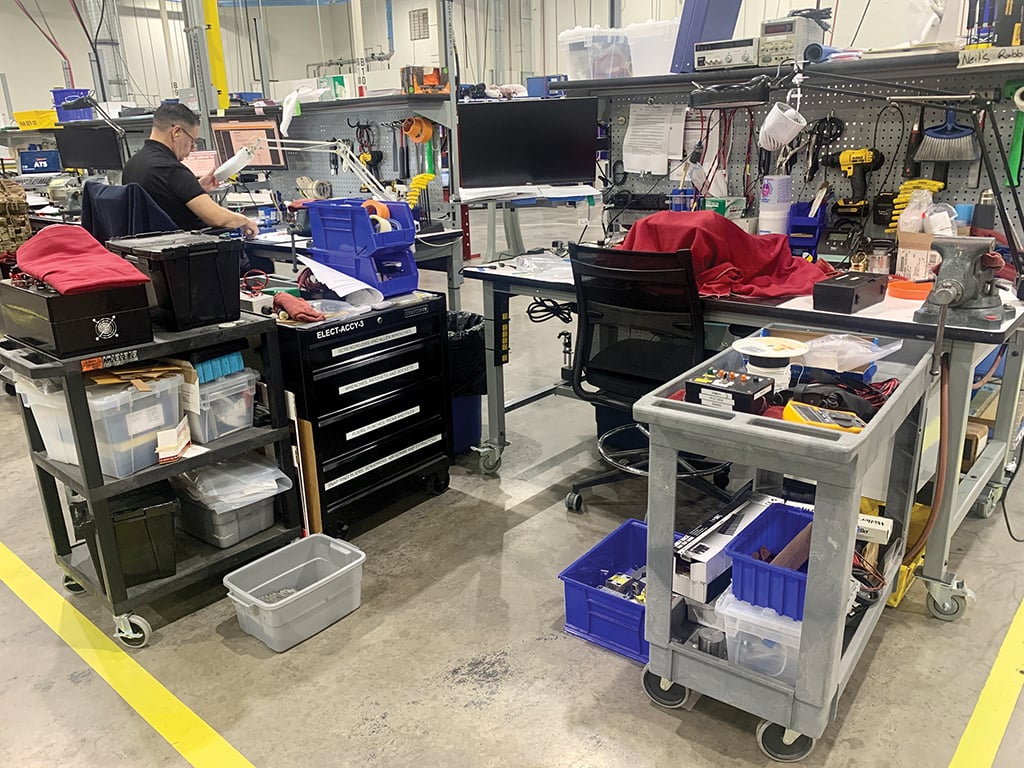
ATS Components DFW repairs a variety of structural parts.
Executives at Aviation Technical Services knew the consolidation of four independent component shops into one streamlined facility would not be easy. In hindsight, they say they underestimated the level of difficulty.
But one year after the complex integration finished, Aviation Technical Services (ATS) is beginning to reap the benefits of ATS Components DFW.
“We built something here that wasn’t here before,” ATS CEO Paul Dolan tells Aviation Week. “It’s a completely different business.”
The journey started in 2015 when the company purchased Texas Air Composites (TAC), a Fort Worth-based repair station specializing in structures work, such as nacelle parts, radomes and flight control surfaces. While not clear then, the acquisition of the 138,000-ft.2 shop built a foundation for a diverse components-focused business unit, all housed within TAC’s walls.
A year later, ATS bought another Dallas-area company: fuel and pneumatic components repair specialist Texas Pneumatic Systems (TPS). Machining specialist Aviation Industry Repair (AIR), acquired by TPS in 2015, came with the deal.
In 2018, ATS’ component spending spree continued with the acquisition of yet another local shop, American Cooler Service (ACS). Its specialties included heat exchangers, fuel systems and electromechanical components.
Consolidating four businesses in the same geographic area that have capability overlap made sense on the surface. But it presented many underlying challenges. Among the largest: blending company cultures and consolidating back-office functions. The executives chose to tear each business apart and create a new (and ideally better) operation.
“We bought these separate companies, and they did all these things well. And they made money,” says Phil Fields, ATS senior vice president of commercial, programs and planning. “So what happened? We bought them, and we broke them.”
ATS announced its Dallas-area facility consolidation plan in August 2020, with Senior Vice President-Operations Trey Bryson tasked with leading the transition and the resulting entity. The company determined that TAC’s facility was large enough to house all four businesses, but not without major revamping.
Work began in February 2021. The first step was a monthslong, floor-to-ceiling overhaul of TAC’s shop, coupled with shedding excess inventory and other items taking up valuable space. By mid-2021, with the structures shop working around the renovations, the space was ready to welcome TPS and ACS.
Relocating two parts overhaul operations introduces inevitable delays. ATS did not expect the moves to be headache-free, and it prepared accordingly. Executives tackled the issue head-on with affected customers, Dolan says, dividing them into three tiers.
Tier 1s—large, longtime customers such as major airlines and manufacturers—were given priority. Tier 2s were told turnaround times would likely be at least a few weeks longer than expected. Tier 3s were hit with delays of 4-5 months and an ATS offer to send parts back or to another facility at ATS expense.
The moves did not go as scheduled. A planned 14-day shutdown at TPS and ACS stretched to 30 days. ATS did not freeze incoming customer parts shipments, creating a larger-than-planned backlog for the streamlined operation.
Consolidation and refinement of spare parts inventories took until January 2022—a headache-inducing six months that created more disruption for the facility’s early days.
Validating the inventory and getting it into the new Oracle Enterprise Resource Planning (ERP) system required “a lot of blood, sweat and tears,” Bryson says. “There’s not a person here who did not spend time in the stockroom with pull sheets. We went and touched every single part, sometimes just to verify that it was, in fact, where it was supposed to be.”
The logjam meant mechanics were not getting all the parts they needed on time, creating more delays for customers. “We made a lot of people mad,” Bryson acknowledges.

But the inventory consolidation’s timing was necessary, even amid the broader disruption inherent in the moves. “We could not have different inventories,” he says. “We had to do the ERP transition.”
Applying lessons learned from the first two moves, AIR joined the new facility in March 2022 and was turning parts at the new shop within three days.
The transition challenges were significant, but the opportunities they helped create should allow ATS to reap long-term benefits.
Reconfiguring the TAC facility went far beyond new paint and electrical wiring. ATS developed a new fuel system testing area, complete with an isolated chamber to minimize workers’ exposure to vapors. The legacy AIR machine shop area has separate rooms for dirty processes that generate residue—boring, grinding and deburring—and clean processes. Composite layup work is done in a dedicated space.
The revamp extended to each mechanic’s workstation as well. Management wanted each station, or cell, to be custom-tailored. Electronic components would go to an electronics cell, making tool allocation and parts delivery easier. Critically, they let the employees decide what exactly was required. “We worked with the mechanics and said, ‘What do you need based on [your] jobs?’” Bryson says.
“The mechanics got to choose what we bought,” Dolan adds. “We didn’t say, ‘Here, we’ve selected these tools for you.’ They got to decide.”
Bespoke workstations are part of a larger process that emphasizes efficiency and nimbleness. Mechanics start their shifts by setting expectations for the day’s work. It might be completing a defined number of jobs or reaching a certain point on one job. A shop floor lead checks in twice during the day—once at lunch and once near the end of the shift, resetting schedules along the way if needed.
“We log that information,” Bryson says. “We look at that, and we [ask]: Do we need training? Do we need tools? How do we close any gaps?”
Bryson introduced the idea at ATS’ Kansas City, Missouri, heavy airframe facility and exported it to Dallas.

“We do that at every one of our shops, with every one of our work cells, with every one of our leads,” Bryson says. One result: Some key productivity metrics “are substantially higher than they were at the legacy companies,” he adds. “And that’s a big part of it.”
While impressive on paper, new tools and dedicated shop areas are worthless without employee buy-in. Forging a single new, sustainable culture has been perhaps the most difficult aspect of ATS’ journey, Dolan says. But it is happening.
“We’re not around the corner yet, but there’s a lot of positive momentum,” says John Bottkol, a shop floor lead technician and supervisor who has been with ATS—and before that, TPS—for 26 years. “As [a TPS veteran], I know what we were capable of, and we are more than capable of exceeding that with what we have now.”
Executives have used myriad tactics to blend parts of the old companies into ATS Components DFW. Some, such as maintaining the character of the old shops by hanging the same flags or permitting apparel with legacy company logos, are straightforward. Others are more creative.
One example is a companywide cornhole tournament with a few culture-nurturing wrinkles. Teams had to include staffers from different divisions, not just friends from the same legacy business, for instance. Practice sessions to hone beanbag-tossing skills were held on company time.
Not all of the tactics have worked, but the net effect has been positive. Bottkol estimates the company’s culture is about “an eight or a nine” out of 10, a notable improvement compared to before the integration.
“Change is difficult,” he says. “We are making strides toward big goals.”
The consolidation’s benefits are beginning to mount. Some employees are now cross-trained so resources can be deployed within the facility as needed.
“We are early in that process, but we are immersed in it,” Bryson says. “Work ebbs and flows all over this place, so we cross-train. People in structures can go work in components.”
Familiarity among the legacy workforces with what each area specializes in has kept some work in-house.
One longtime customer, a major U.S. carrier, called the legacy TPS accessories shop about a job. The accessories team said it was a better fit for the machine shop, so that is where the work went.
Customer exposure to all four legacy businesses is opening doors as well. One longtime accessories and components customer—another U.S. major—sent very little structures work to the old TAC. That may change.
“We are having real, meaningful conversations with them about that today, because we’re all in the same place,” Bryson says. “It’s not dealing with two different companies. It’s the same vendor code. Now they can try us out for structures.”
As ATS works to ramp up its consolidated components business, priorities have shifted. The next steps include expanding capabilities, developing more products internally and, most important, fortifying customer support.
“Now that we’re stable, we’re having these discussions around bringing someone in that can build a lot of new capability here,” Dolan says. “We don’t have a new product introduction engineer. So that’s the place where we need to go. What are we going to do on new aircraft types? A lot of the shop’s legacy was on old airplanes. So that’s part of the future. But we are just now able to have those kind of conversations, because we’re delivering the parts that we do well.”
ATS is “not out of the penalty box yet” with customers that grew wary during the consolidation, Fields says, but volumes are increasing. Meanwhile, some old standby jobs at the legacy shops, such as engine mount overhauls, are flowing in.
Bolstering customer service should amplify those trends.
“We’re not incredible today,” Bryson says. “I think we’re fairly decent, and we’re getting better every day. But there are lots of shops that do very good work. So if you’re not the cheapest and you have competitors doing very good work, that differentiator to me then becomes customer service.”





